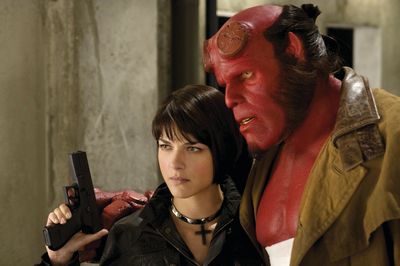Sequel aches for heroic save

Years ago, someone cracked about Harrison Ford: “With a hat, he’s a star. Without, he’s not.”
I’m beginning to think another axiom may serve as a good rule of thumb for director Guillermo del Toro: With subtitles, he’s an artist. Without, he’s just a good genre filmmaker.
That’s not the worst thing in the world, of course – a quick survey of summer movies will show you there are few enough directors up to epic stories and complicated special effects.
But it’s still a wide gulf between the two roles.
In his own language, the Mexican director makes such waking dreams as “The Devil’s Backbone” and “Pan’s Labyrinth.” In the Hollywood idiom, he directs “Mimic” and “Blade II.”
One kind of movie is a five-course meal. The other is a big bucket of popcorn.
“Hellboy II: The Golden Army” comes from the junk-food side of the menu. A sequel to del Toro’s 2004 entertainment, it brings back that devilish superhero – living secretly in Trenton, N.J. – and his friends, the aquatic Abe Sapien and the flaming Liz Sherman, all super-secret government agents.
To Earth, Water and Fire the movie now adds Air – or protoplasm, at least, in the shape of the shape-shifting Johann Krauss. And then it gives the team a new challenge, in the form of an evil prince and his indestructible army.
Oh, hell. Time to save the world again.
The returning actors include Ron Perlman as Hellboy – who’s at least meant to be grumpy – and, as Liz, Selma Blair, an actress who always seems to be in a bad mood no matter who she’s playing. (The graceful mime Doug Jones adds some welcome lightness to the glum proceedings as the fussy Abe.)
It’s crowded, yet you can almost feel del Toro straining to keep interested. There’s a peacock demon, with eyes in its wings, who wouldn’t have felt out of place in that labyrinth; some of the later effects, despite their modern polish, feel like a nod to the ’50s wonders of Ray Harryhausen.
And, as in the classic Universal movies on Hellboy’s TVs, there’s plenty of not-so-comic comic relief – including a Barry Manilow sing-along.
But, hard as he’s working here, del Toro can’t quite cover up the fact that this is a not-particularly needed sequel to a not-especially memorable movie.
The initial sight of Perlman’s superhero devil – complete with sawed-off horns and flicking tail – is still a spectacle, and it’s a relief to see a film that, unlike “The Incredible Hulk,” makes its wonders out of man and makeup instead of pixels and programming.
But there’s not much to this character, and Hellboy’s dialogue – mostly a muttered “Oh, crap” – is hardly worthy of his time.
That’s true too, fatally, of the villains.
The Batman and Spider-Man movies know the rules; they give their heroes a worthy challenge. But who does Hellboy face? An insolent prince with a posh accent, a pale face and lank white hair.
We need a Joker, a Green Goblin, a Doc Oc. Instead we get someone who looks like Julian Sands’ stand-in from “Warlock.”
Del Toro dutifully brings everyone together and, in the final scenes, manages to stage some interesting fights.
Unlike some other summer movie entertainments, “Hellboy II” doesn’t drag and it doesn’t cheat; it promises a few basic pleasures (stuff blowing up! scary monsters!) and it delivers.
But it’s del Toro telling stories in the language of Hollywood. And I miss the language of his dreams.
For times and locations, see page 11.